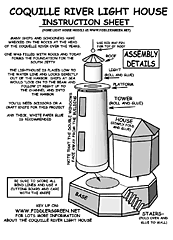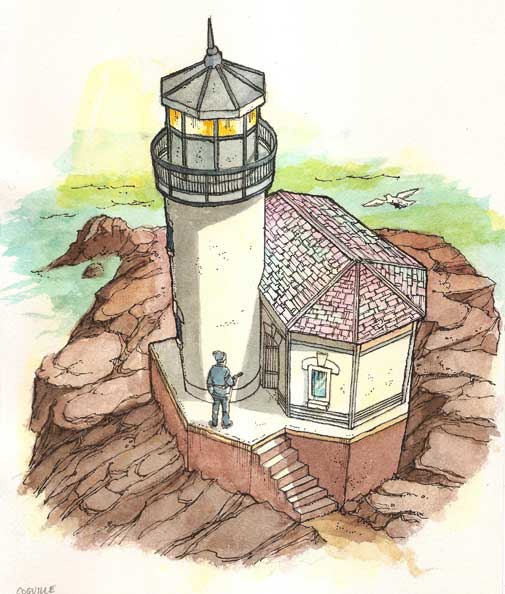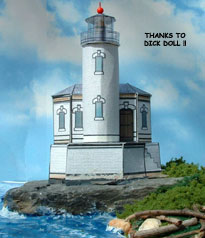



Coquille River Light House at Bandon on the Sea, Oregon 

Coquille River Lighthouse, built in 1896, once had a beam that could be seen as far as out to sea. The lighthouse was abandoned by the Coast Guard as an aid to navigation in 1939.
This little 40-foot-tall lighthouse protected ships from the shallows of the Coquille River from 1896 until 1939 during a period of busy lumber shipping in and out of Port Bandon, Oregon.
It is now restored and maintained as part of Bullards Beach State Park. Today, the inactive lighthouse on the river's north jetty in Bandon, Oregon, is open to visitors through Bullard's Beach State Park, just north of the Coquille River Bridge on Highway 101.
An automated light on a nearby jetty replaced the old station that had deteriorated over nearly a half century.
The Coquille River Light House at Bandon on the Sea

|
Lightkeepers and their families sometimes worked for days shoveling coal. The coal furnace heated the boiler to produce steam for the horn |
The geographic location of Bandon at the mouth of the Coquille
River made it the hub of all river transportation. Inbound merchandise
and passengers were transferred from their ocean-going vessels
to riverboats for delivery to upstream destinations. Valley farm
products and outbound travelers were transferred at Bandon for
their journeys to other ports. Dozens of boats would be in the
harbor at a time, loading and unloading freight and lumber.
But shoals at the mouth of the river made the bar entrance unpredictable. If the entrance to the Coquille River was to be of any real commercial use, jetties were essential. In 1887 the south jetty was built. Dredging created a depth of 10-12 feet at high tide, but shoaling continued to be a problem. By 1888, officials knew that a lighthouse and a jetty on the north side of the river were essential.
 |
 The Coquille lighthouse sporting its new colors (left and right) |
 |
Families had chores, too, but were not compensated for their labors. Women rowed their children across the river to go to school. During a storm at night, family members often went on 4-hour shifts in the tower to make sure the light did not blow out. Lighthouse inspectors were notorious for surprise inspections, and women were required to keep their quarters as clean and polished as the lighthouse.
The Coquille River Lighthouse presents a relatively simple
exterior due to the small scale of the structure, and resembles
characteristics of the High Victorian Italian ate style. On average,
it is 10-15 feet from the base of the structure to the water below.
The tower measures 47 feet from its base.

The lightroom was equipped with a Fourth Order Fresnel Lens, illuminated by a Funck Heap lamp, and was visible 12 miles at sea on a clear night. The orders refer to the size of the lens; the first order is the largest. The signal beam was on for 28 seconds, off 2 seconds, signifying that it was a "Harbor Light." Shutters eclipsed the light for the 2-second occlusion, and were operated by a clock mechanism.
The fog horn was a DaBoll Trumpet. Its signature was a blast of 5 seconds, followed by a silent interval of 25 seconds. It was replaced by a fog siren in 1910. By 1939, technical navigational apparatus was commonplace, and marine beacons, foghorns, and lightkeepers became obsolete. The Coast Guard extinguished the light at the Coquille River Lighthouse and replaced it with an unwatched automated beacon at the end of the south jetty. It was the end of an era: the light was removed from the tower and the lighthouse abandoned.
When Bullards Beach State Park was created in 1964, it assumed responsibility for the lighthouse. By 1979, vandalism and weather damage had been repaired and the lighthouse restored. Today, a solar powered light in the tower of the lighthouse re-creates the grandeur of yesterday for Bandon and area residents.
Volunteer interpreters offer tours to the tower of the lighthouse during summer months, which remains closed the rest of the year. Special accommodations can be made for groups by calling the park of office. Gift shop open 10-4 daily during the summer. All proceeds go to the lighthouse restoration fund.
| Your lighthouse models
will be nicely displayed on flat rocks or interesting chunks
of drift wood. Refer to the instructions included with the model You can print out an extra copy, (in fact, as MANY copies as you wish...) and build up the windows. Strips of cardstock to build up the trim, and EVEN a tiny doll house light bulb shining through cellophane windows...An inexpensive crystal hanging in the light room...?? hmmmmm |
 The model is basically in just three parts: The Tower, House, and Base. Each is just one piece and easy to fold and glue.. |
Although the Coquille River is navigable for dozens of miles
upstream, early coasting mariners generally  bypassed it rather
than risk crossing the treacherous bar across its mouth. Unpredictable
currents frequently caused the sandy obstruction to shift, sometimes
reducing clearance in places to as little as three feet. Sailors
attempting the tricky passage did get past, but not always. The
schooner Commodore, which wrecked here in 1870, heads a long list
of ones which failed. Upriver towns, anxious to deal their lumber
and other commodities to the rest of the world, were consequently
slower to develop than they otherwise might have.
bypassed it rather
than risk crossing the treacherous bar across its mouth. Unpredictable
currents frequently caused the sandy obstruction to shift, sometimes
reducing clearance in places to as little as three feet. Sailors
attempting the tricky passage did get past, but not always. The
schooner Commodore, which wrecked here in 1870, heads a long list
of ones which failed. Upriver towns, anxious to deal their lumber
and other commodities to the rest of the world, were consequently
slower to develop than they otherwise might have.
In 1880, Congress recognized the need to spur area trade and approved funds to build a jetty on the south side of the river entrance-to create a deeper, more stable channel. After its completion three years later, the suddenly busier river prompted cries for a guiding light to herald approaching ships.
 Local
officials approached Congress with the idea in 1886, but the measure
bogged down in governmental bureaucracy, and it was 1895 before
approval was gained, suitable land acquired, a contractor hired,
and work began. The chosen site was Rackleff Rock, a tiny islet
at the north side of the river's mouth. Workers constructed a
40 foot, stucco-covered brick tower with attached fog signal house
and connected them to the mainland via a wooden walkway. The station
began active service 29 February 1896.
Local
officials approached Congress with the idea in 1886, but the measure
bogged down in governmental bureaucracy, and it was 1895 before
approval was gained, suitable land acquired, a contractor hired,
and work began. The chosen site was Rackleff Rock, a tiny islet
at the north side of the river's mouth. Workers constructed a
40 foot, stucco-covered brick tower with attached fog signal house
and connected them to the mainland via a wooden walkway. The station
began active service 29 February 1896.
Declining river traffic in the 1930s prompted the closing of the Coquille River Lighthouse in favor of a system of day marks and automated beacon. The fourth-order lens was removed, the keepers dismissed, and the station shut down.
Over the years, the abandoned tower deteriorated as unthinking visitors removed bricks and mortar and scrawled unsightly graffiti across its surface.
Following the creation of Bullocks Beach State Park in the 1960s park officials worked jointly with the Corps of Engineers to complete a major restoration of the badly decayed structure before reopening it to the public in 1979.
 PGI (pretty good instructions) |
 In 1991, the town of Brandon's centennial celebration included a ceremonial relighting of Coquille River Light, utilizing a solar powered low wattage light solely for decorative purposes. The entire structure is draped in festive tree lights every Christmas. Contact Bullards Beach State Park. PO Box 569 Bandon, OR 97411: phone 541- 347-2209. |



